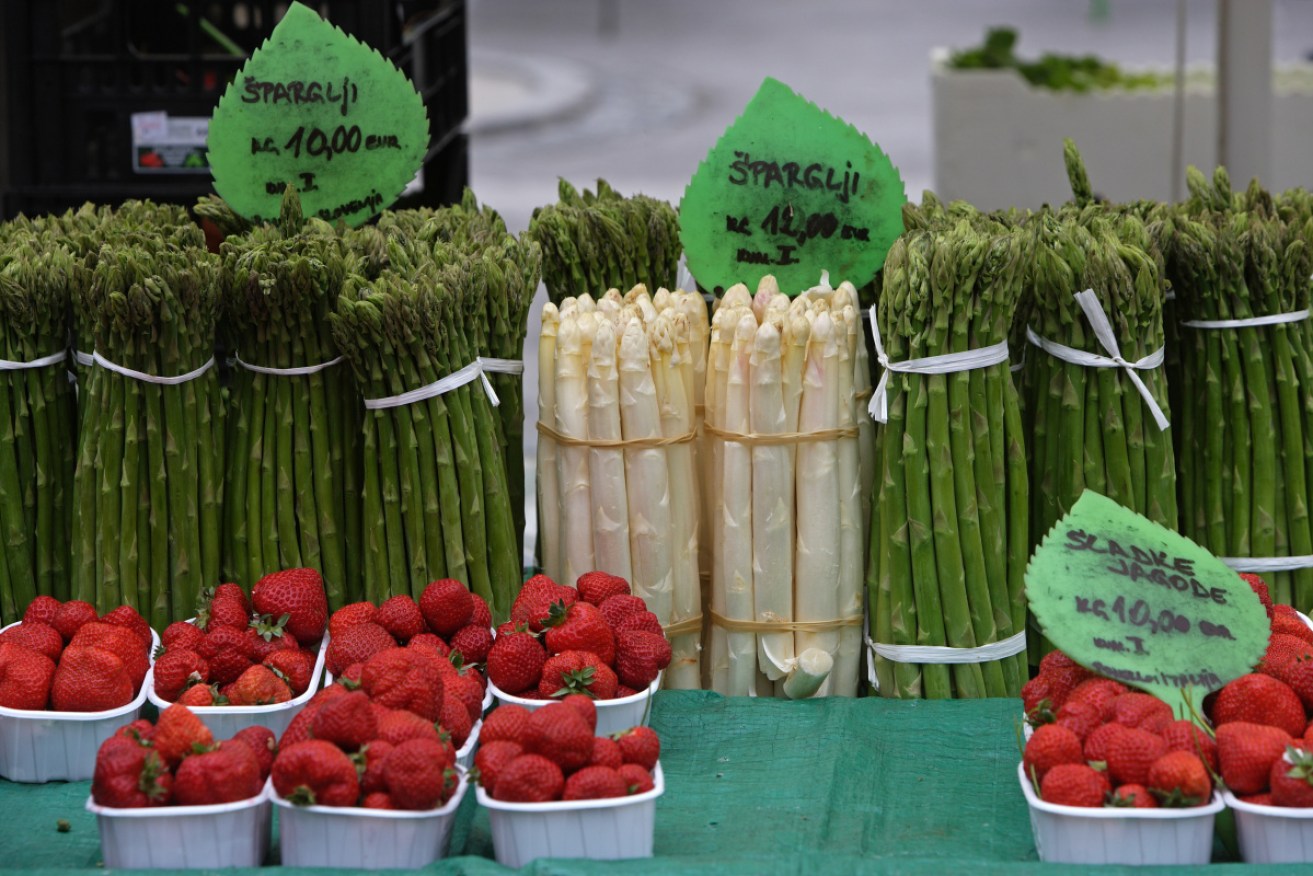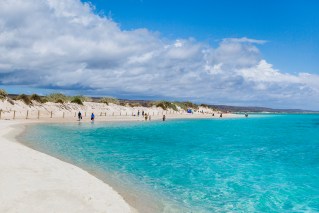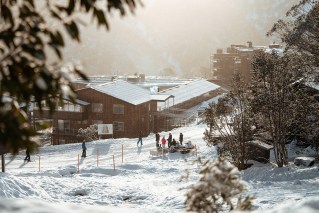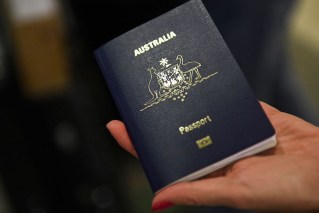Europe’s newest food destination might surprise you


Produce for sale at a market in Slovenia's capital, Ljubljana. Photo: Getty
You might have difficulty locating it on a map, but whispers are that this tiny country with serious food cred is edging its way to pole position on food lovers’ travel bucket lists.
Dobro Tek! (Bon appetit!)
It’s 11am and we are drinking sparkling wine and eating what are reputed to be the best sausages in Ljubljana, Slovenia. It’s sausage-seller Stanislav Loga Stanc’s birthday and despite looking like he’s been partying all night, he insists on popping the cork on a bottle of Srebra Radgonska.
Stanc’s hole-in-the-wall sausage shop, Klobasarna, in Ljubljana’s cobbled old town, was once his family’s watch repair business, but in 2013 he chose to swap timepieces for carniolan (aka kransky) sausages – the payoff, regular queues down the street.
Slovenians are both voracious gourmands and consummate enablers. We walk into bars, cafes and restaurants and no matter the time of day, find people eating meals with bottles of Slovenian wine and craft beer. Wherever we go, people push drinks into our hands and food into our mouths.
At a geographical and cultural crossroads, Slovenia shares borders with Croatia, Italy, Austria, and Hungary and draws inspiration from the best of those cuisines. With snow-dusted alpine peaks, windswept plains and a bite-sized piece of coastline, it’s a verdant and produce-rich country, the cuisine seriously (and for us, unexpectedly) sophisticated.
It’s something that Michelin has acknowledged, recently announcing that it’ll publish its first Slovenia guide in 2020, with chefs such as Janez Bratovz of Restaurant JB; 2017 winner of San Pellegrino Best Female Chef, Ana Roš from Hiša Franko and Tomaž Kavčič of Gostilna pri Lojzetu all tipped to take out coveted stars.

Anna Ros is one of the star local chefs expected to feature in the new Michelin guide.
At Vila Planinka, high in the mountains, chef Jakob Jerala, who’s worked with Heston Blumenthal and Magnus Nilsson at Fäviken in Sweden, supports the hotel’s ethos of hyper local, sustainable food.
He feeds us small golden trout from alpine streams, truffles shaved over gnocchi made from local buckwheat, a prosciutto that is (sorry Italians!) even better than the famed San Daniele, wild forest mushrooms, home-baked bread and house-churned butter, winter strawberries, and tea made from mountain herbs.
Slovenian sweets include a retinue of traditional cakes, often eaten at specific times of the year.
Bled cream cake transcends special occasion restrictions. We try it in situ, overlooking the ethereal Lake Bled – it’s essentially a posh custard slice that covers us with icing sugar and pastry fragments, but is totally worth the kilojoules and the clean-up.

Janez Bratovz is the chef at one of the country’s most famous restaurants, Restaurant JB.
‘Na Zdravje! (Cheers!)
Slovenians really, really love wine. The country is home to one of the oldest producing vines in the world, at 400 years old. There are 28,000 wineries (in a country that is only 20,000 square kilometres) and apparently one in every 10 Slovenians owns grape vines.
The guide on our food tour in Ljubljana also points out that the Slovenian national anthem, Zdravilica (Toast), inaugurated in 1989, is basically a drinking song.
It’s worth exploring the capital’s many wine bars, loudly and proudly promoting Slovenia’s excellent and very reasonably priced wine, but it’s even more of a pleasure to get out into the extraordinarily picturesque countryside and visit the wineries themselves.
In the Vipava Valley in the east of the country, one of Slovenia’s nine distinct wine regions, our car is buffeted by a wind known as the Burja (or Bora if you’re across the border in Italy). Fortunately, it’s only a half-hearted blow, because this often-ferocious wind can howl at speeds of as much 200km/h.
In addition to the wind, Burja is the name of one of the country’s most highly regarded wineries. On the edge of the village of Podnanos (population 364), this small but impressive winery offers tours and tastings by appointment.
Winemaker Primož Lavrenčič’s family have lived and made wine here since 1499 and, apart from an inherited planting of pinot noir, he still grows grapes indigenous to the valley, ageing his wine in cement ‘egg’ tanks and barrels of Croatian oak.
In Jezersko, we continue our education with a sommelier-guided tasting of wines like the low-alcohol Cviček, made from a mix of red and white grapes (and until recently not considered good for much but mixing as a spritzer), to some seriously good ‘serious’ wines.
There’s a strong focus on orange wines, biodynamic practices, interesting blends and all kinds of experimentation with fermentation and ageing vessels.
There’s also a growing craft beer movement. Look out for the HumanFish, Tektonic and Reservoir Dogs brands.Then there’s zganje –a much loved, throat-burning schnapps that can take the unwary by surprise.
It’s hard not to want to take some of Slovenia home and at Ljubljana airport my bags, stuffed with edible treasures such as pumpkin seed oil, wine and honey, herbal tea, sea salt, and chocolate are found to be overweight.
I’m offered the choice of paying a $164 excess fee or losing some weight. It’s a no-brainer – I simply abandon a down-at-heel pair of boots and a couple of bobbly jumpers and get on my way. I expect my personal excess holiday weight gain won’t be as easy to shed though.
Getting there
There are no direct flights from Australia to Ljubljana. There are flights with connections from Belgrade or fly into Venice or Zagreb with a bus or train transfer of roughly two hours to Ljubljana.
Where to eat
Restaurant JB, Ljubljana
Klobasarna, Ljubljana
Hiša Franko, Kobarid
Gostilna pri lojzetu, Vipava
Where to stay
Grand Union Hotel, Ljubljana
Bled Rose Hotel, Lake Bled
Theodosius Forest Village, Vipava
Vila Planinka, Jezersko

The accommodation at Theodosius Village. Photo: Natascha Mirosch
When to go
Slovenia is a year-round destination; but spring is popular, while autumn, when the forest foliage turns all shades of red and gold, is particularly beautiful.
Slovenia is a very small country, and for a first-time visit (because you will want to go back) a week is probably sufficient.
Spend a few days in in the pretty, green capital of Ljubljana, then hire a a car and see the country in a clockwise direction. Head south-west to Postojna Caves, a spectacular 24-kilometre long karst cave system, (take a tour of the secret underground listening station found in the bowels of the Jama Hotel at the cave complex when they were renovating) and visit the nearby Predjama Castle – a renaissance-era castle built in a cave mouth.
Spend a few days exploring the charming small villages and wineries of the Vipava Valley, then continue north east to Trigalev National Park, Lake Bohinji and the dreamy lake Bled.
Nature lovers shouldn’t miss the alpine peaks, meadows and placid turquoise lakes of the Jezersko Valley. More information here.









